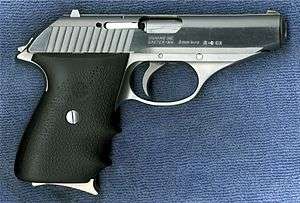SIG Sauer P230
| SIG P230 / P232[1] | |
|---|---|
|
A SIG P232 SL | |
| Type | Semi-automatic pistol |
| Place of origin | Germany, Switzerland |
| Service history | |
| Used by | See Users |
| Production history | |
| Designed | 1977 |
| Manufacturer | SIG Sauer, SIGARMS |
| Produced | P230 1977–1996 P232 1996-2015 |
| Specifications | |
| Weight | 520 g (18.5 oz) [1] |
| Length | 17 cm (6.6 in) [1] |
| Barrel length | 9.1 cm (3.6 in) [1] |
| Width | 3.0 cm (1.2 in) [1] |
| Height | 12 cm (4.7 in) [1] |
|
| |
| Cartridge | .32 ACP, .380 ACP and 9×18mm Police |
| Action | Double Action/Single Action (DA/SA) With decocking lever |
| Feed system |
8-round magazine (.32 ACP) 7-round magazine (.380 ACP & 9mm)[2] |
| Sights | Fixed front and rear |
The SIG Sauer P230 is a small, semi-automatic handgun chambered in .32 ACP or .380 Auto. In 1996[3] it was replaced by SIG Sauer with the model P232.[4]
Design
The design and function of the P230 is of the simple fixed barrel, straight blow-back configuration. It has a reputation as a well-built firearm, and competes with the smaller Walther PPK. With its relatively narrow slide and frame it can be carried in an ankle holster or beneath body armor.
The P230 was available in both blued and all-stainless finishes. The blued version features a blued steel slide and a matching, anodized aluminum frame, whereas the stainless version was completely made from stainless steel. Both versions came with a molded polymer, wrap-around grip that is contoured to give the shooter a comfortable and secure hold on the pistol.
The trigger comes from the factory with a 24 newtons (5.5 lbf) single-action pull, and is capable of both single-action and double-action. Pulling back the slide sets the hammer backwards and downwards to its single-action position, making for a very short trigger pull, with minimal take-up. The double-action pull is longer and more stiff. It has no external safeties, though it does have a de-cocking lever positioned just above the right-handed shooter's thumb, on the left side of the grip. The lever provides for a safe method of lowering the hammer from its full-cocked, single-action position, to a "half-cock", double-action safe position where the hammer itself falls forward to a locking point about an eighth of an inch from the rear of the firing pin. Once de-cocked, it is physically impossible for the hammer to drop completely and contact the firing pin, which would otherwise greatly increase the risk of the unintentional discharge of a chambered round. In order for the round to discharge, the full double-action pull would have to be completed, which allows for the pistol to be carried reasonably safely with a round chambered. In addition, the SIG P232 has an automatic firing pin safety.[3]
The sights are of the traditional SIG design and configuration, with a dot on the front sight and a rectangle on the rear sight. To aim using the sights, the shooter simply aligns the dot over the rectangle. The magazine release is located behind and below the magazine floor plate. The magazine is released by pushing the lever towards the rear of the grip, at which point the magazine can be removed from the pistol.
Overview
Due to its small dimensions, it is easily carried as a backup weapon or as a concealed carry handgun, holding 8 + 1 rounds of .32 ACP or 7 + 1 rounds of .380 ACP (9mm Kurz), respectively. A special police model was available, chambered in 9mm Police, actually a 9×18mm casing, which is very similar to 9mm Kurz but slightly more powerful.
Users
-
 Japan: Various police forces.[5]
Japan: Various police forces.[5] -
 Switzerland: Various police forces.[6]
Switzerland: Various police forces.[6] -
 United Kingdom: Special Air Services (SAS).[7]
United Kingdom: Special Air Services (SAS).[7] -
 United States: Various police forces.[6]
United States: Various police forces.[6]
References
- 1 2 3 4 5 6 "P232". SIG Sauer. Retrieved 7 December 2012.
- ↑ Peterson, Philip. Gun Digest Book of Modern Gun Values: The Shooter's Guide to Guns 1900 to Present (16th ed.). p. 208.
- 1 2 http://world.guns.ru/handguns/hg115-e.htm
- ↑ http://www.sigsauer.com/Products/ShowCatalogProduct.aspx?categoryid=10
- ↑ Ayoob, Massad (9 July 2004). The Gun Digest Book of Sig-Sauer: A Complete Look At Sig-Sauer Pistols. Iola, Wisconsin: Gun Digest Books. p. 58. ISBN 1-4402-2713-6.
- 1 2 Marchington, James (2004). The Encyclopedia of Handheld Weapons. Lewis International, Inc. ISBN 1-930983-14-X.
- ↑ "SAS Weapons - Handguns". Elite UK Forces. Retrieved 2015-04-08.
